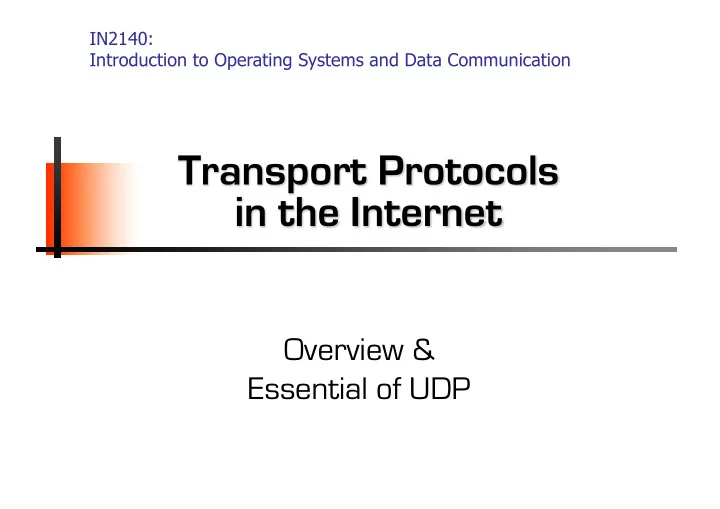

IN2140: Introduction to Operating Systems and Data Communication Transport Protocols in the Internet Overview & Essential of UDP
Transport Layer Function Transport layer tasks 5 5 Application Application 1. Addressing Transport Transport 4 4 Layer Layer 2. End-to-end connection management Network Network 3 3 Layer Layer 3. Transparent data transfer 1-2 1-2 between processes University of Oslo IN2140 – Introduction to operating systems and data communication - 2
Transport Service Transport § Connection oriented service Port Protocol − 3 phases Service Interface • connection set-up Application Application 5 • data transfer Layer Layer • disconnect Transport Transport 4 Entity Entity § Connectionless service Network Network − Transfer of independent 3 Layer Layer messages 1-2 IP: Message § Realization: transport entity TCP/IP 1. Port − Software and/or hardware 2. IP address !! − Software part usually contained ISO TSAP within the kernel (process, library) (transport service access point) University of Oslo IN2140 – Introduction to operating systems and data communication - 3
Transport Layer Function Transport layer tasks 5 5 Application Application 1. Addressing Transport Transport 4 4 Layer Layer 2. End-to-end connection management Network Network 3 3 Layer Layer 3. Transparent data transfer 1-2 1-2 between processes 4. Quality of service options • Error recovery • Reliability • Flow control • Congestion control University of Oslo IN2140 – Introduction to operating systems and data communication - 4
Congestion and Flow Control Opposite objectives Opposite objectives § Network § End-system − Optimize overall throughput − Optimize its own throughput − Possibly at the expense of other end-systems Congestion Flow control control Transmission rate Two different problems adjustment • Receiver capacity • Network capacity Internal congestion Cannot be distinguished easily at all places Network But should be differentiated Small receiver Large receiver capacity capacity Packet loss University of Oslo IN2140 – Introduction to operating systems and data communication - 5
Transport Layer Function § Transport protocols of TCP/IP protocols − Services provided implicitly UDP DCCP TCP SCTP Connection-oriented service X X X Connectionless service X Ordered X X Partially Ordered X Unordered X X X Reliable X X Partially Reliable X Unreliable X X X With congestion control X X X Without congestion control X Multicast support X X Multihoming support X University of Oslo IN2140 – Introduction to operating systems and data communication - 6
Transport Service: Terminology § Nesting of messages, packets, and frames Packet header Message header Message Payload Frame header Packet Payload Frame Payload TCP/IP Message ISO TPDU Layer Data Unit (transport protocol data unit) Transport Message, Packet Network Packet Data link Frame TCP name for Message Payload: Segment Physical Bit/symbol (bitstream) UDP name for Message: Datagram University of Oslo IN2140 – Introduction to operating systems and data communication - 7
Internet terminology § TCP sends a stream of bytes − it doesn’t offer a packet service to the application layer § TCP content could be divided across multiple IPv4 packets (fragmentation) − but then all content is destroyed with the loss of one IPv4 packet − also, fragmentation in IPv6 is only allowed at the sender (using an option), where TCP can do it better − so TCP splits its content into segments that fit into an L3 packet § hence normally message = packet − and in everyday work: packet ≈ message or packet ≈ segment − distinction from context University of Oslo IN2140 – Introduction to operating systems and data communication - 8
Transport Protocols UDP
UDP - User Datagram Protocol • UDP is a simple transport protocol − Unreliable − Connectionless − Message-oriented • UDP is mostly IP with short transport header − De-/multiplexing − Source and destination port − Ports allow for dispatching of messages to receiver process University of Oslo IN2140 – Introduction to operating systems and data communication - 10
UDP: Message Format Version IHL Type of service PRE ToS Total length Identification D M Fragment offset Time to live Protocol Header checksum IP header Source address Destination Address Options Source port Destination port UDP header Used for demultiplexing: Packet length Checksum service address Data • • Source port Packet length − Optional − In byte (including UDP header) − 16 bit sender identification − Minimum: 8 (byte) i.e. header without data − Response may be sent there • Checksum • Destination port − Optional in IPv4 − Receiver identification − Checksum of header and data for error detection University of Oslo IN2140 – Introduction to operating systems and data communication - 11
UDP: Message Format – Checksum • Purpose − Error detection (header and data) • UDP checksum includes 1. UDP header (checksum field initially set to 0) 2. Data 3. Pseudoheader • Part of IP header Source address § source IP address Destination Address § destination IP address 00000000 Protocol=17 UDP segment length § Protocol § length of (UDP) data • Allows to detect misdelivered UDP messages • Use of checksum optional − i.e., if checksum contains only "0"s, it is not used • Transmit 0xFFFF if calculated checksum is 0 University of Oslo IN2140 – Introduction to operating systems and data communication - 12
UDP: Ranges of Application • Suitable − For simple client-server interactions, i.e. typically • 1 request packet from client to server • 1 response packet from server to client − When delay is worse than packet loss and duplication • Video conferencing • IP telephony • Gaming • Used by e.g. − DNS: Domain Name Service ¹ − NTP: Network Time Protocol ¹ − SNMP: Simple Network Management Protocol − BOOTP: Bootstrap protocol − TFTP: Trivial File Transfer Protocol − NFS: Network File System ¹ − RTP: Real-time Transport Protocol ¹ ¹ can also be used with TCP University of Oslo IN2140 – Introduction to operating systems and data communication - 13
Recommend
More recommend